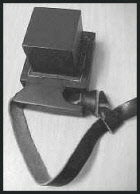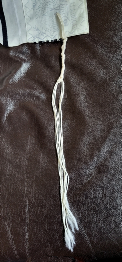ICJudaism: A Teacher’s Guide to Judaism
Hosted by ICTeachers Formerly: Mike’s Rough Guide to Judaism
Disclaimer:
The contents of these pages represent the author’s personal views, experience and
understanding.
There are bound to be some things here that some Jews would disagree
with.
Symbols 2
Tefillin The Shema, the daily prayer which begins with Deut.6:4-
Both tefillin and mezuzot serve as visual reminders of God's commandments.
This photograph shows the tefillin which is worn on the arm. It is known as the Shel Yud (meaning “for the hand"). The Shel Rosh (“for the head”) has 2 straps, which, in use, hang behind the head and over the front of the shoulders.
You may see tefillin referred to in books as Phylacteries (but never by Jews). The word is Greek in origin and means an amulet ie good luck charm, which definitely is not what tefillin are.
Wearing tefillin for daily prayer is referred to as “laying tefillin” and, like fixing a mezuzah to a door post, is a way of fulfilling the commandments in the to remember God’s laws (the Shema includes the instruction: You shall bind them for a sign on your hand ,and they shall be for ornaments between your eyes).

Tzitzit (tassel) Another commandment that forms the basis of an important Jewish
symbol is found in Numbers 15:37-
A tzitzit (plural, tzitzyot) is made from 4 threads, one much longer than the others, which are doubled through a hole in the garment and then wrapped with the longest of the four in a complex pattern of turns and knots which has both religious and numerological significance.
Tallit or Tallis The most common way in which the commandment is fulfilled is by wearing of a tallit, or prayer shawl during morning prayer. A tallit is made of rectangular piece of cloth and has a tzitzit in each corner. Tallitot (plural) are worn by men and, in progressive communities, increasingly by women, too.
Tallit & Tallis are differing pronunciations of the same word.
A tzitzit attached to the corner of a tallit.
Very observant Jewish men also wear, throughout the day, a special four cornered garment called a tallit katan. It is like a small tallit with a hole in the middle to put your head through (it's a bit like a small poncho) and is worn under the shirt with just the tzitzyot hanging out where they can be seen.
A tallit must be large enough to drape around the shoulders and must have a collar (thus making it a garment). Other than this the size and proportions of a tallit are of no religious significance. A tallit may be long and thin (eg 30 cm X 1.5 m), square (up to 2m is common) or anything between. The important features are the 4 corners each with it's tzitzit. Traditionally tallitot are decorated with blue or black stripes, but other more colourful decorations are becoming more popular.

Head Covering It is usual for Jewish men to cover their heads when they pray or study. This is a sign of submission to, and respect for, God. Very observant Jewish men will keep their heads covered at all times (except in bed), since they are always in the presence of God. Head covering is a custom rather than a law.
Any hat will do but the most common headcovering is the skull cap, which is know
as a kupple, yarmulke (both yiddish terms) or kippah (Hebrew). Kippot come in a wide
range of sizes, materials and designs -
In progressive communities it is becoming quite common for women, too, to wear a kippah.


